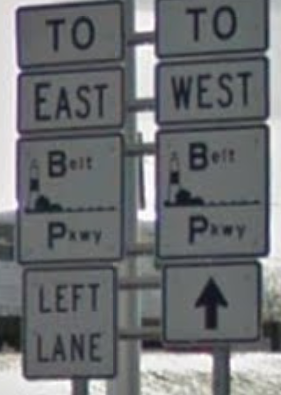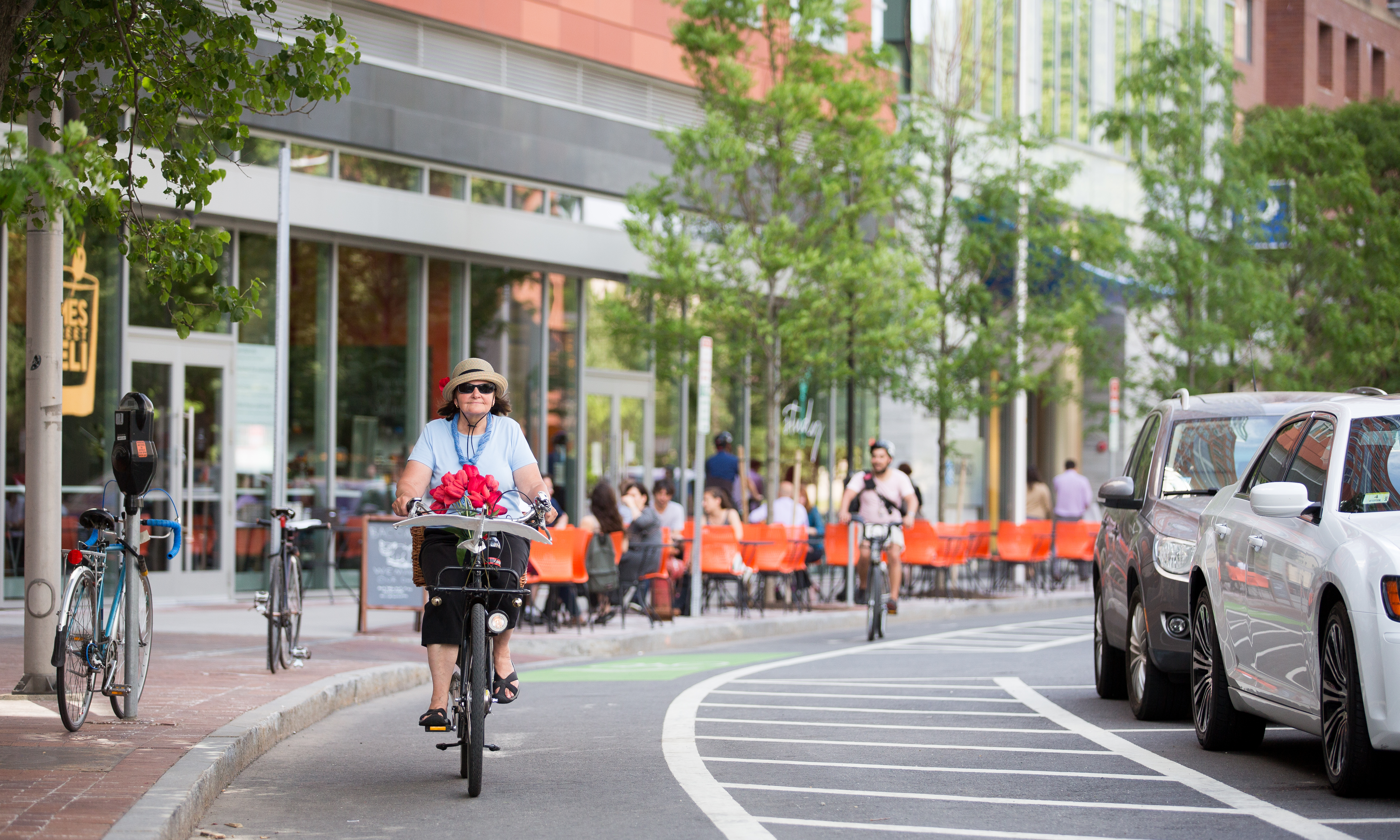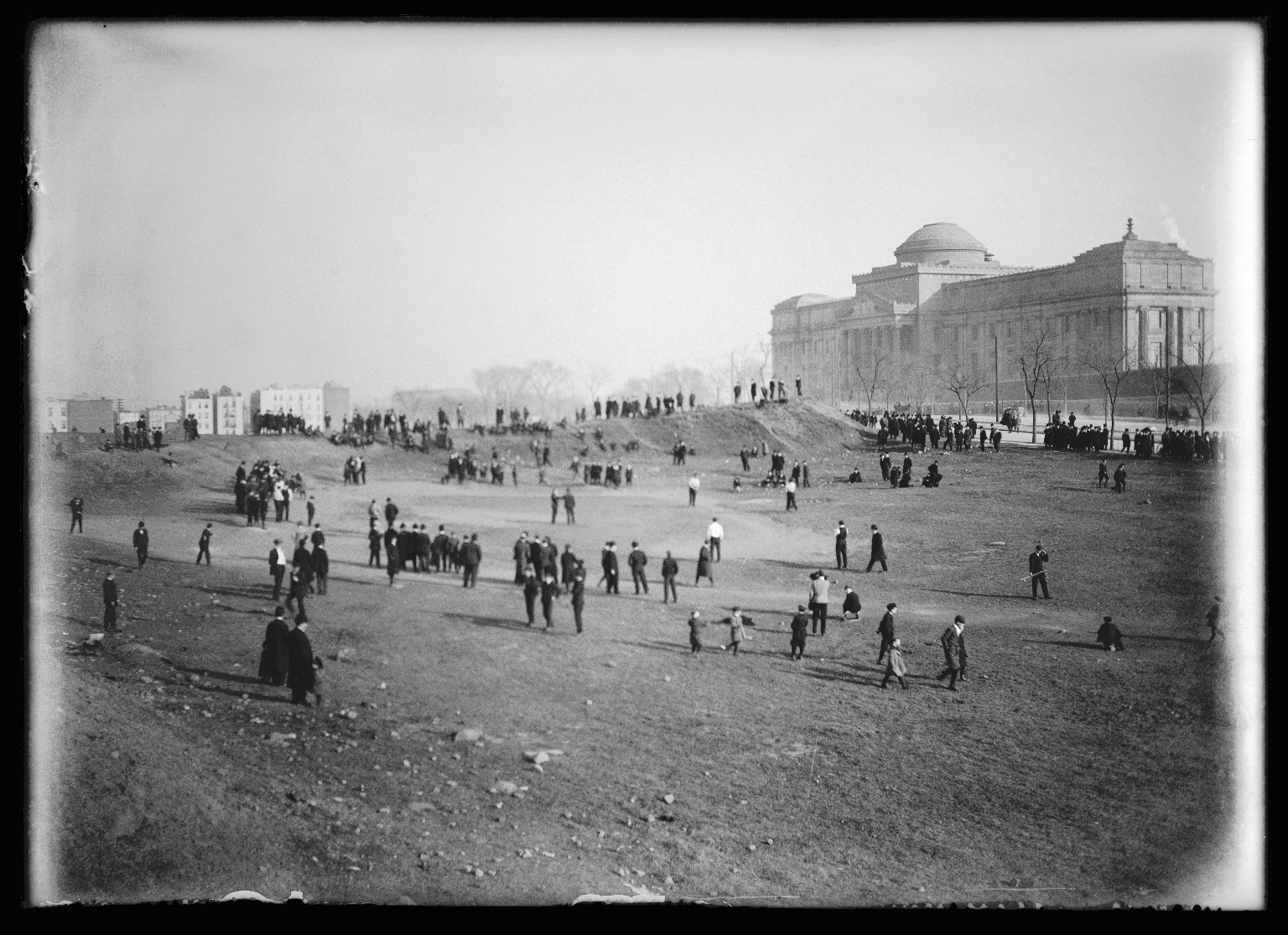|
Ocean Parkway (Brooklyn)
Ocean Parkway is a boulevard in the west-central portion of the New York City borough of Brooklyn. It is inventoried by the New York State Department of Transportation (NYSDOT) as New York State Route 908H (NY 908H), an unsigned reference route. Route description Ocean Parkway extends over a distance of about five miles (8 km), running almost north to south from Machate Circle at the southwestern corner of Prospect Park to the Atlantic Ocean waterfront at Brighton Beach. The NYSDOT designates the section south of Church Avenue as an unsigned reference route. Ocean Parkway begins at Machate Circle at the southern entrance of Prospect Park and travels westward before merging south into Prospect Expressway. After the expressway ends at Church Avenue, then passes through Windsor Terrace and what is present-day Kensington. The parkway runs roughly parallel to Coney Island Avenue, an important commercial avenue several blocks to the east. After running through sev ... [...More Info...] [...Related Items...] OR: [Wikipedia] [Google] [Baidu] |
NYSDOT
The New York State Department of Transportation (NYSDOT) is the department of the Government of New York (state), New York state government responsible for the development and operation of highways, Rail transport, railroads, mass transit systems, ports, waterways and aviation facilities in the U.S. state of New York (state), New York. This transportation network includes: * A state and local highway system, encompassing over 110,000 miles (177,000 km) of highway and 17,000 bridges. * A 5,000 mile (8,000 km) rail network, carrying over 42 million short tons (38 million metric tons) of equipment, raw materials, manufactured goods and produce each year. * Over 130 public transit operators, serving over 5.2 million passengers each day. * Twelve major public and private ports, handling more than 110 million short tons (100 million metric tons) of freight annually. * 456 public and private aviation facilities, through which more than 31 million people travel each year. It ow ... [...More Info...] [...Related Items...] OR: [Wikipedia] [Google] [Baidu] |
Coney Island Avenue
Coney Island Avenue is a road in the New York City borough of Brooklyn that runs north-south for a distance of roughly five miles, almost parallel to Ocean Parkway and Ocean Avenue. It begins at Brighton Beach Avenue in Coney Island and goes north to Park Circle at the southwest corner of Prospect Park, where it becomes Prospect Park Southwest. Near-parallel Ocean Parkway terminates five blocks south and three blocks west of that intersection, becoming the Prospect Expressway (New York State Route 27). Ocean Parkway originally extended north to Park Circle, where Coney Island Avenue meets Prospect Park, until construction of the Prospect Expressway replaced the northern half-mile of Ocean Parkway but included ramps to the edge of Prospect Park. Coney Island Avenue frontage is dominated by mixed-use housing: pre-war apartment buildings, small shops, including many antique shops, and service businesses. The B68 bus line runs along Coney Island Avenue, connecting the Prospect Par ... [...More Info...] [...Related Items...] OR: [Wikipedia] [Google] [Baidu] |
Belt Parkway
The Belt Parkway is the name given to a series of connected limited-access highways that form a belt-like circle around the New York City boroughs of Brooklyn and Queens. The Belt Parkway comprises three of the four parkways in what is known as the Belt System: the Shore Parkway, the Southern Parkway (not to be confused with the Southern State Parkway), and the Laurelton Parkway. The three parkways in the Belt Parkway are a combined in length. The Cross Island Parkway makes up the fourth parkway in the system, but is signed separately. Route description The Shore Parkway, Southern Parkway, Laurelton Parkway, and Cross Island Parkway are collectively known as the "Belt System". The four components of the Belt System are designated as New York State Route 907C (NY 907C), NY 907D, NY 907B, and NY 907A, respectively, by the New York State Department of Transportation. All four numbers are reference route designations and are not signed. Excluding the Cros ... [...More Info...] [...Related Items...] OR: [Wikipedia] [Google] [Baidu] |
Brighton Line (BMT)
The BMT Brighton Line, also known as the Brighton Beach Line, is a rapid transit line in the B Division of the New York City Subway in Brooklyn, New York City, United States. Local service is provided at all times by the Q train, but is joined by the B express train on weekdays. The Q train runs the length of the entire line from Coney Island–Stillwell Avenue to the Manhattan Bridge south tracks. The B begins at Brighton Beach and runs via the bridge's north tracks. The line first opened in 1878 as a two-track surface-level excursion railroad called the Brooklyn, Flatbush and Coney Island Railway, transporting riders from Downtown Brooklyn via a connection with the Long Island Rail Road (LIRR) to the seaside resorts at Coney Island. When its connection with the LIRR was severed in 1883, the line became the Brooklyn and Brighton Beach Railroad, which was eventually acquired by the Brooklyn Rapid Transit Company (BRT, later Brooklyn–Manhattan Transit Corporation MT. From 19 ... [...More Info...] [...Related Items...] OR: [Wikipedia] [Google] [Baidu] |
Culver Line (BMT)
The IND Culver Line (formerly BMT Culver Line) is a rapid transit line of the B Division of the New York City Subway, extending from Downtown Brooklyn south to Coney Island, Brooklyn, New York City, United States. The local tracks of the Culver Line are served by the F service, as well as the G between Bergen Street and Church Avenue. The express tracks north of Church Avenue are used by the <F> train during rush hours in the peak direction. The peak-direction express track between Ditmas Avenue and Avenue X has not seen regular service since 1987. The line is named after Andrew Culver, who built the original Culver Line that preceded the current subway line. The present-day line was built as two unconnected segments operated by the Independent Subway System (IND) and Brooklyn–Manhattan Transit Corporation (BMT). The northern section of the line, between Jay Street–MetroTech and Church Avenue, is a four-track line that was built for the IND in 1933, running p ... [...More Info...] [...Related Items...] OR: [Wikipedia] [Google] [Baidu] |
Metropolitan Transportation Authority
The Metropolitan Transportation Authority (MTA) is a public benefit corporation responsible for public transportation in the New York City metropolitan area of the U.S. state of New York. The MTA is the largest public transit authority in the United States, serving 12 counties in Downstate New York, along with two counties in southwestern Connecticut under contract to the Connecticut Department of Transportation, carrying over 11 million passengers on an average weekday systemwide, and over 850,000 vehicles on its seven toll bridges and two tunnels per weekday. History Founding In February 1965, New York Governor Nelson Rockefeller suggested that the New York State Legislature create an authority to purchase, operate, and modernize the Long Island Rail Road (LIRR). The LIRR, then a subsidiary of the Pennsylvania Railroad (PRR), had been operating under bankruptcy protection since 1949. The proposed authority would also have the power to make contracts or arrangements with ... [...More Info...] [...Related Items...] OR: [Wikipedia] [Google] [Baidu] |
New York City Department Of Transportation
The New York City Department of Transportation (NYCDOT) is the agency of the government of New York City responsible for the management of much of New York City's transportation infrastructure. Ydanis Rodriguez is the Commissioner of the Department of Transportation, and was appointed by Mayor Eric Adams on January 1, 2022. Former Commissioners have included Polly Trottenberg, Janette Sadik-Khan, and Iris Weinshall Responsibilities The Department of Transportation's responsibilities include day-to-day maintenance of the city's streets, highways, bridges, sidewalks, street signs, traffic signals, and street lights. DOT supervises street resurfacing, pothole repair, parking meter installation and maintenance, and municipal parking facility management. DOT also operates the Staten Island Ferry. DOT is the exclusive provider of day-to-day operations and maintenance on state-maintained roads and highways in city limits, while major repairs and capital improvements on state-owned road ... [...More Info...] [...Related Items...] OR: [Wikipedia] [Google] [Baidu] |
Government Of New York City
The government of New York City, headquartered at New York City Hall in Lower Manhattan, is organized under the New York City Charter and provides for a mayor-council system. The mayor is elected to a four-year term and is responsible for the administration of city government. The New York City Council is a unicameral body consisting of 51 members, each elected from a geographic district, normally for four-year terms. All elected officials are subject to a two consecutive-term limit. The court system consists of two citywide courts and three statewide courts. New York City government employs approximately 330,000 people, more than any other city in the United States and more than any U.S. state but three: California, Texas, and New York. The city government is responsible for public education, correctional institutions, public safety, recreational facilities, sanitation, water supply, and welfare services. New York City consists of five boroughs, each coextensive with one ... [...More Info...] [...Related Items...] OR: [Wikipedia] [Google] [Baidu] |
Bike Lane
Bike lanes (US) or cycle lanes (UK) are types of bikeways (cycleways) with lanes on the roadway for cyclists only. In the United Kingdom, an on-road cycle-lane can be firmly restricted to cycles (marked with a solid white line, entry by motor vehicles is prohibited) or advisory (marked with a broken white line, entry by motor vehicles is permitted). In the United States, a ''designated bicycle lane'' (1988 MUTCD) or ''class II bikeway'' (Caltrans) is always marked by a solid white stripe on the pavement and is for 'preferential use' by bicyclists. There is also a ''class III bicycle route'', which has roadside signs suggesting a route for cyclists, and urging sharing the road. A ''class IV separated bike way'' (Caltrans) is a bike lane that is physically separate from motor traffic and restricted to bicyclists only. Effects According to a 2019 study, cities with separated bike lanes had 44% fewer road fatalities and 50% fewer serious injuries from crashes. The relationship w ... [...More Info...] [...Related Items...] OR: [Wikipedia] [Google] [Baidu] |
Median Strip
The median strip, central reservation, roadway median, or traffic median is the reserved area that separates opposing lanes of traffic on divided roadways such as divided highways, dual carriageways, freeways, and motorways. The term also applies to divided roadways other than highways, including some major streets in urban or suburban areas. The reserved area may simply be paved, but commonly it is adapted to other functions; for example, it may accommodate decorative landscaping, trees, a median barrier, or railway, rapid transit, light rail, or streetcar lines. Regional terminology There is no international English standard for the term. Median, median strip, and median divider island are common in North American and Antipodean English. Variants in North American English include regional terms such as neutral ground in New Orleans usage. In British English the central reservation or central median the preferred usage; it also occurs widely in formal documents in som ... [...More Info...] [...Related Items...] OR: [Wikipedia] [Google] [Baidu] |
Eastern Parkway
Eastern Parkway is a major road that runs through a portion of the New York City borough of Brooklyn. Designed by Frederick Law Olmsted and Calvert Vaux, it was the world's first parkway, having been built between 1870 and 1874. At the time of its construction, Eastern Parkway went to the eastern edge of Brooklyn, hence its name. The road begins at Grand Army Plaza (the main entrance to Prospect Park) and extends east to Ralph Avenue, along the crest of the moraine that separates northern from southern Long Island. This section runs parallel to Atlantic Avenue and is aligned with the Crown Heights street grid. East of Ralph Avenue, it turns to the northeast, still following the moraine, until it terminates at Bushwick Avenue near the Evergreen Cemetery, where the moraine climbs steeply toward a peak at Ridgewood Reservoir. The initial portion of Eastern Parkway, west of Ralph Avenue, contains landscaped medians and is officially called by that name. The part east of Ralph Av ... [...More Info...] [...Related Items...] OR: [Wikipedia] [Google] [Baidu] |
Riegelmann Boardwalk
The Riegelmann Boardwalk (also known as the Coney Island Boardwalk) is a boardwalk along the southern shore of the Coney Island peninsula in the New York City borough of Brooklyn, facing the Atlantic Ocean. Opened in 1923, the boardwalk runs between West 37th Street at the edge of the Sea Gate neighborhood to the west and Brighton 15th Street in Brighton Beach to the east. It is operated by the New York City Department of Parks and Recreation (NYC Parks). The Riegelmann Boardwalk is primarily made of wooden planks arranged in a chevron pattern. It ranges from wide and is raised slightly above sea level. The boardwalk connects several amusement areas and attractions on Coney Island, including the New York Aquarium, Luna Park, Deno's Wonder Wheel Amusement Park, and Maimonides Park. It has become an icon of Coney Island, with numerous appearances in the visual arts, music, and film. After its completion, the boardwalk was considered the most important public works project in Broo ... [...More Info...] [...Related Items...] OR: [Wikipedia] [Google] [Baidu] |




.jpeg)


_76_-_Riegelmann_Boardwalk.jpg)